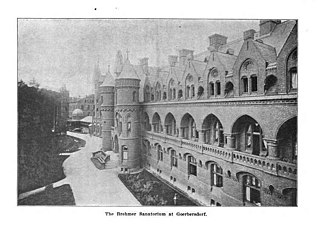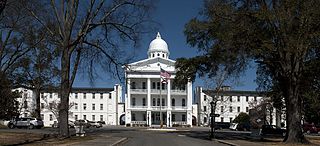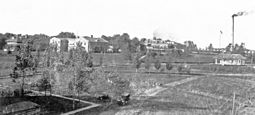
The Iowa Department of Corrections is a state agency operating prisons in Iowa. It has its headquarters in Des Moines.

A sanatorium, also sanitarium or sanitorium, are antiquated names for specialised hospitals, for the treatment of specific diseases, related ailments and convalescence. Sanatoriums are often in a healthy climate, usually in the countryside. The idea of healing was an important reason for the historical wave of establishments of sanatoriums, especially at the end of the 19th- and early 20th centuries. One sought, for instance, the healing of consumptives, especially tuberculosis or alcoholism, but also of more obscure addictions and longings of hysteria, masturbation, fatigue and emotional exhaustion. Facility operators were often charitable associations such as the Order of St. John and the newly founded social welfare insurance companies.

Bryce Hospital opened in 1861 in Tuscaloosa, Alabama, United States. It is Alabama's oldest and largest inpatient psychiatric facility. First known as the Alabama State Hospital for the Insane and later as the Alabama Insane Hospital, the building is considered an architectural model. The hospital currently houses 268 beds for acute care, treatment and rehabilitation of full-time (committed) patients. The Mary Starke Harper Geriatric Psychiatry Hospital, a separate facility on the same campus, provides an additional 100 beds for inpatient geriatric care. The main facility was added to the National Register of Historic Places in 1977.

Muirdale Tuberculosis Sanatorium, also called Muirdale Tuberculosis Hospital, was built in 1914–15 by Milwaukee County, Wisconsin. It was located near the corner of Highway 100 and Watertown Plank Road in Wauwatosa and named after noted Wisconsin naturalist John Muir. Maximum capacity in 1923 was 350 patients, but in later years this figure rose to over 600, including a 100-bed Children's Cottage, or Preventorium, devoted to the treatment of young children.

UF Health Jacksonville is a teaching hospital and medical system of the University of Florida in Jacksonville, Florida, United States. Part of the larger University of Florida Health system, it includes the 603-bed UF Health Jacksonville hospital, the 92-bed UF Health North hospital, associated clinics, and is the Jacksonville campus of UF's Health Science Center. Together with UF Health Shands Hospital in Gainesville, UF Health Jacksonville is one of two academic hospitals in the UF Health system, and serves 19 counties in Florida and several in Georgia.

Modern Woodmen of America (MWA) is one of the largest fraternal benefit societies in the United States, with more than 750,000 members. Total assets reached US$15.4 billion in 2016. Though it shares the same founder, it is not affiliated financially in any way with another, similarly-styled fraternal benefit society, WoodmenLife, and despite the name "Modern" is actually older than its counterpart.

Pancheros Mexican Grill is a chain of fast casual Tex Mex restaurants in the United States serving Mexican-style cuisine. The chain was founded in 1992 by Rodney Anderson when he opened two units: one in Iowa City, Iowa, and one in East Lansing, Michigan. There are currently 72 units throughout the country. Pancheros is known for making their tortillas on site, at the time the order is placed. In 2006, Sports Illustrated voted Pancheros the most popular place to eat when bars in Iowa City close.

Glen Lake Sanatorium, a tuberculosis treatment center serving Hennepin County in Minnesota, opened on January 4, 1916, with a capacity of 50 patients, and closed in 1976. In 1909, the Minnesota State Legislature had passed a bill authorizing the appointment of county sanatorium boards and appropriating money for the construction of county sanatoriums. Glen Lake Sanatorium was the fifth of fourteen county sanatoria that opened in Minnesota between 1912 and 1918. Glen Lake was the first U.S. tuberculosis sanatorium to be accredited by the American Medical Association.The sanatorium had its own post office, and the mailing address was Glen Lake Sanatorium, Oak Terrace, Minnesota, until the surrounding area was incorporated into the City of Minnetonka.

Englert Theatre in Iowa City, Iowa, is a renovated vaudeville-era playhouse now serving as a community arts center and 725-seat performance venue. It is owned and operated year around by Englert Civic Theatre, a non-profit art organization. The building was individually listed on the National Register of Historic Places in 2001. In 2021, it was included as a contributing property in the Iowa City Downtown Historic District.
The Mississippi State Hospital (MSH) is a psychiatric facility operated by the Mississippi Department of Mental Health. It is located in the unincorporated community of Whitfield, Rankin County, Mississippi, along Mississippi Highway 468. The 350-acre (140 ha) campus is 15 miles (24 km) southeast of Jackson, between Jackson and Brandon. Historically many people referred to the center as "Whitfield," after the community in which it is located.
George Pearson Centre is a long term residential care facility located in the Marpole neighbourhood of Vancouver, British Columbia, and is currently owned and operated by Vancouver Coastal Health. George Pearson Centre was named after former BC Minister of Health, George S. Pearson. Built in 1952 to originally treat tuberculosis patients and then polio patients, in the 1960s the focus of George Pearson Centre changed to long term care for adults with disabilities.

The Allen Hazen Water Tower, also known as the Municipal Water Tower, is a historic structure located on the west side of Des Moines, Iowa, United States. It was listed on the National Register of Historic Places in 2004.

Cranberry Specialty Hospital was a tuberculosis sanatorium and later a chronic care facility in Hanson, Massachusetts operated by Plymouth County, Massachusetts, which was operational from 1919 until 1992.

Graylands Hospital is Western Australia's largest mental health inpatient facility, and the only public stand-alone psychiatric teaching hospital. It is located on a 10-hectare (25-acre) site in Mount Claremont, in a suburb formerly known as Graylands, after which the hospital was named. The hospital has 178 beds, including 30 beds in the Frankland Centre, and 320 nurses on staff.
The town of Colorado Springs, Colorado, played an important role in the history of tuberculosis in the era before antituberculosis drugs and vaccines. Tuberculosis management before this era was difficult and often of limited effect. In the 19th century, a movement for tuberculosis treatment in hospital-like facilities called sanatoriums became prominent, especially in Europe and North America. Thus people sought tuberculosis treatment in Colorado Springs because of its dry climate and fresh mountain air. Some people stayed in boarding houses, while others sought the hospital-like facilities of sanatoriums. In the 1880s and 1890s, it is estimated that one-third of the people living in Colorado Springs had tuberculosis. The number of sanatoriums and hospitals increased into the twentieth century. During World War II, medicines were developed that successfully treated tuberculosis and by the late 1940s specialized tuberculosis treatment facilities were no longer needed.

Ethan Allen School for Boys was a reform school in Delafield Town, Wisconsin which operated in a former tuberculosis sanitorium from April 1959 until June 2011, when it was abolished and the inmates moved to Lincoln Hills School in Irma. It was operated by the Wisconsin Department of Corrections.
Luther Ellsworth Utterback was an American artist, who primarily worked in sculpture and painting. He was known for his large-scale installations in public spaces and corporate buildings.

Knoxville Veterans Administration Hospital Historic District is a nationally recognized historic district located in Knoxville, Iowa, United States. It was listed on the National Register of Historic Places in 2012. The first part of the property that was developed is a cemetery, which is located in the middle of the former VA golf course. It contains 40 plots. The State Industrial Home for the Blind was opened on the site of what would become the Veterans Administration Hospital on January 1, 1892. It remained in operation until April 30, 1900, when the last patient moved out. Two years later the facility was transformed into the State Hospital for Inebriates, which was a place of detention and treatment for males addicted to morphine, cocaine and other narcotics. Local citizens protested, and it was closed a few years later.

The Firland Sanatorium was Seattle's municipal tuberculosis treatment center. It opened on May 2, 1911, and closed on October 30, 1973.

Robert C. Broshar was an American architect in practice in Waterloo, Iowa from 1956 to 1996. He spent nearly his entire career with the firm now (2023) known as INVISION Architecture and was president of the American Institute of Architects for the year 1983.



















